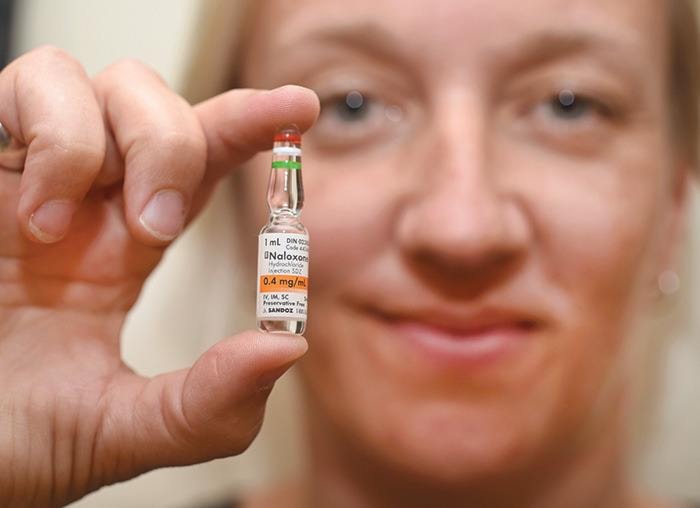It’s a number Heather Hobbs finds alarming.
So far this year, staff at AIDS Vancouver Island (AVI) have responded to 40 drug overdoses in their drop in space — triple the amount the agency responded to in 2013.
With no designated space to safely use drugs, the clients who utilize the agency’s harm reduction services have been known to use in the washrooms or outside before they come in. Some stop breathing from an overdose in the presence of AVI staff.
Hobbs said so far staff have managed to prevent any deaths from occurring thanks to the administration of naloxone — a medication that reverses the effects of an overdose from opioids such as heroin, methadone or morphine by restoring breathing within two to five minutes. The effects last for at least 30 minutes, giving time for emergency responders to arrive.
“It’s become part of what we do and on the other hand, that shouldn’t be happening to that degree. It does take a toll on not only the people who are experiencing overdoses, but responders, including our staff,” said Hobbs.
AVI has trained around 1,300 people since 2013 on how to use naloxone kits, and has dispensed more than 1,000.
The kits are mainly distributed to drug users who are at risk of overdosing and those who spend time with them, such as friends and family, since a drug user can’t administer naloxone themselves.
At this time last year, a prescription was needed to access the kit, but last spring Health Canada opted to loosen restrictions on the medication amid soaring overdose rates linked to the powerful synthetic opioid fentanyl — which is often mixed into other street drugs to unsuspecting users, but is 100 times more potent than morphine, heroin or oxycodone.
Shortly after Health Canada’s decision, the College of Pharmacists of B.C. announced it had made changes to allow naloxone be sold by a pharmacist without a prescription, making it one of the first jurisdictions in Canada to do so.
Hobbs said some pharmacies in Victoria are now ready to roll, but it’ll take time for all of them to get on board. The kits typically sell for about $50 to $60, but are free through the province’s Take Home Naloxone Program. More than a dozen agencies in Victoria and Esquimalt now distribute the kits, which supply injectable naloxone.
Historically, only ambulances, hospitals and some clinics used naloxone, but the medicine is also being distributed to firefighters and most recently police. Victoria police are currently in the process of training officers and civilian staff on how to use the naloxone nasal spray, which was approved by Canada’s health minister in July.
Even though police aren’t typically dispatched to overdose calls, officers may come across people overdosing while out on patrol, and could also be accidentally exposed to fentanyl. At least three B.C. RCMP officers are known to have had contact with the deadly drug while on duty. RCMP officers across Canada will soon carry the spray in case they are accidentally exposed. Front-line officers in Vancouver are also doing the same.
“After recent incidents in B.C. with police officers having adverse reactions from fentanyl exposure, this is a welcomed step to provide an extra layer of protection for our members,” said Sgt. Sean Plater, president of the VicPD Union. “Our members are coming across people that are overdosing on the street and this will also provide our officers the ability to help those people too.”
For Hobbs, the more people that have access to naloxone, the better, but the medicine is only one piece of the complicated puzzle around overdose prevention.
Hobbs is one of several people in the community who sees a need for a supervised consumption site. Victoria council has made the provision of safe consumption services by the end of 2016 part of its strategic plan and is currently working with Island Health and police to make that happen.
“I think it’s (naloxone distribution) absolutely necessary and it should have happened sooner. It’s taken a public health emergency to spur more people into action around this,” said Hobbs, who would like to see the spray become more readily available, but it currently comes with a hefty cost, running as high as $125 per two doses. The injectible form costs about $5 to $20 per dose.
“It’s obviously less intimidating to administer a nasal spray than to draw a dose you inject into somebody a number of times. Typically most people require at least three, but sometimes up to six or seven doses, so the spray is obviously way less complicated.”
In April, the province’s health officer declared drug-related overdoses to be a public health emergency. Between 2011 and 2015, there was an average of 19 illicit drug-related deaths per year in Victoria. That number spiked in 2016 to 29 illicit drug-related deaths in the first six months. In 2015 there were 17 deaths.
